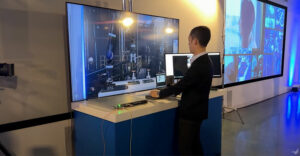The world of work is changing, and new technologies are transforming how companies hire, train, and manage their employees.
With Covid, increased numbers of people have been working remotely, and many will continue to do so post-pandemic. This has fundamentally altered how work is done; not only by company staff, but by HR professionals.
This societal shift, combined with the continued emergence of new digital technologies, means that the field of human resources is in the midst of radical evolution.
“I think companies are going to struggle to get staff back into the office full time, so we are likely a turning point in history where people increasingly leave the high rents of cities to work remotely,” Richard Evans, careers mentor and founder of The Profs, told TechNewsWorld.
“Firms will need to accommodate this change by investing more in collaborative online work software.”
Virtual Hiring
One essential way that technology is changing human resources practices is in the realm of finding, interviewing, and screening employees. Companies are focused on identifying the right employees for jobs, even as they’re trying to save time and money in the process.
“Covid-19 forced the hand of many organizations to adapt to virtual interviewing,” Hannah Goldenberg, marketing specialist for Spark Hire, explained to TechNewsWorld.
“After realizing the convenience, on top of cost and time savings, many organizations plan to continue their virtual hiring process beyond lockdowns and stay-at-home orders.”
Often, the virtual hiring process can be even more personalized than the traditional one.
“Many companies use HR technology to improve the personalization of their hiring process, be that through more frequent and timely communication with candidates, incorporating video explanations of the positions by current employees, and even outbound recruiting and one-way video interviewing,” added Goldenberg.
Both companies and potential employees are using digital technologies to learn about each other, with the goal of both being to find the right fit.
“Covid has moved everything online, so pre-recorded online interviews are now standard,” said Evans. “Video CVs are on the rise, as employers want to know the personality of their applicants. Jobseekers also care increasingly about the culture and lifestyle of their potential employer. They are putting less and less weighting on maximizing their earnings potential and more on work-life balance and job satisfaction.”
Background and reference checking is also getting a boost from new technologies.
“At a base level, leveraging the power of the cloud and AI are key technology foundations that are important to drive better recruiting and hiring,” Michael Fitzsimmons, co-founder and CEO of Crosschq, told TechNewsWorld.
“In addition to that, mobile usage is a massive consideration. For example, more than 70 percent of Crosschq user activity takes place on mobile devices. Lastly, having easy-to-use APIs that integrate with other platforms is mandatory to help optimize workflows for recruiters and talent teams.”
Management Practices Changing Too
In addition to changes in the recruiting and hiring process, technology is changing how businesses manage their employees.
“While the future of work may be uncertain, what’s clear is the need to put people — and their development — at the center of business,” Jill Popelka, president of SAP SuccessFactors, told TechNewsWorld.
“Over the last year, digital transformation and the pace of change has only accelerated. Learning is the strategic enabler to not only drive business transformation, but to create a culture of resiliency.”
Everything from training to coaching is changing along with new technologies and platforms.
“From a technology lens, organizations need modern learning platforms that unify learning content in one place and create clear pathways for employees to further their personal and professional growth,” explained Popelka.
“Employees need to be able to access learning quickly and easily, effectively collaborate with others, and share knowledge — anytime, anywhere, and across all different systems of work.
“Achieving this requires personalized learning paths with context-based, relevant recommendations — and it should be clear how courses, trainings, and other learning content contribute to an employee’s own development and the goals of the broader organization.”
These shifts are, ultimately, changing the experience of work itself.
“Instilling a culture of learning goes far beyond learning and development platforms,” Popelka continued. “It requires a shift in how we think about work. We have long been focused on what people can do or need to do — such as compliance trainings.
“Now, we need to think about what people want to do. Careers are no longer linear or static. Instead, people will have to learn new skills and switch careers in order to keep up with the pace of change and reinvent entire industries.
“Organizations that can empower employees with learning along their individual career journey will not only drive engagement and excitement, but lay the foundation for a more productive, inclusive, agile, and collaborative future of work.”
Automated HCM
Technological changes are altering many different aspects of human resources, since the practices of hiring, training, and managing employees intersect on multiple levels.
“People are looking for faster, more accurate, more human ways to drive business outcomes,” Rich Wang, vice president of customer success for Observe.AI, told TechNewsWorld. Wang elaborated:
As technology evolves, so does the world of work, and they’re both likely to continue changing significantly over the coming years.
“To address the growing number and intensity of people imperatives, businesses, not just HR, will rely on HCM — human capital management — technologies to automate and augment HR practices so they can elevate people to address the complexities of these mission-critical challenges,” Greg Pryor, executive director of Workday, told TechNewsWorld.
“HR technologies will be more focused on enabling both employee and company success by listening to employees’ needs and leveraging data and machine learning to personalize and prescribe actions and meeting people where they work.”


























































